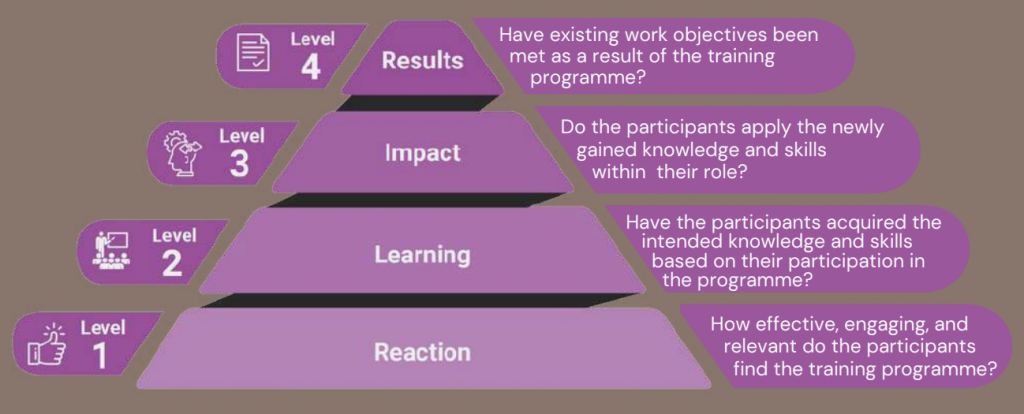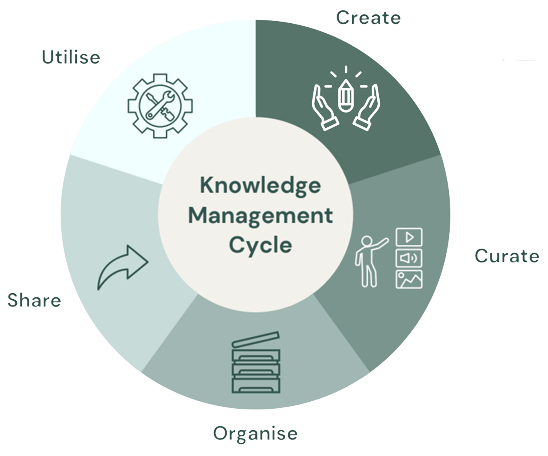Looking into Digital Learning & Development Modules to Empower Social Service Professionals
Prepared by Deborah Abrahams
The quick rise of this paradigm shift has underlined the necessity for organisations to include various Learning & Development (L&D) aspects into their transformation frameworks. A robust L&D structure or framework adds value to an organisation. Implementing this could help organisations to maintain high staff retention levels and assure the success of their digital transformations. By now you are probably wondering how it adds value to your organisation and how you can put an L&D plan in place. Read on to discover more about Learning & Development and get the answers to all of your questions as well as other useful information.
Table of Contents

The rise of new technologies has redefined the meaning of ‘a career’ for many, as more and more people are choosing to move from one employer to the next instead of working for a long time at a single organisation, since they see each position as an opportunity for them to develop both professionally and individually. The rapid emergence of this paradigm shift has highlighted the need for organisations to incorporate various Learning & Development (L&D) elements in their transformation frameworks in order to keep staff retention levels high and ensure the success of their digital transformations.
Having a strong L&D structure or framework in place not only motivates an organisation’s current employees and helps them to develop their individual skills, but it also, as stated earlier, keeps staff retention levels high and facilitates the process of employer branding. The ultimate goal of L&D is to encourage the practice of a value-based culture within an organisation that helps to improve employees’ capabilities, which will, in turn, help to attract potential employees. A successful L&D plan typically incorporates the 70:20:10 model which encourages learning in the workplace, while improving an employee’s performance. The model is known for its wide array of available learning methods, which will be further discussed in this article.
How L&D Creates Value in an Organisation
The main aim of an L&D structure is to create a value-led organisation that motivates employees and strengthens their capabilities. Here are some ways in which L&D creates value for an organisation:

Attracting and Retaining Talent
One of the reasons why people leave their jobs is to find new opportunities for individual development but with an L&D plan, organisations enable their employees to grow and develop themselves both personally and professionally, which helps to retain current staff members while encouraging potential members to join the organisation.

Motivating and Engaging Employees
Organisations that have an integrated L&D plan have employees who are more motivated and productive because they are given the resources and tools to overcome obstacles in their work. Ultimately, L&D ensures that a culture of learning is embedded within organisations.

Building Employer Branding
The improved value and branding of an organisation that implements an L&D plan can attract many potential employees by effectively communicating this added value.

Creating a Value-Based Culture
Many job applicants nowadays look for an employer that upholds a value-based and sustainable work culture, therefore implementing an L&D plan is essential in developing a sense of community that is built upon shared values.

Developing People’s Capabilities
Knowledge and skills will eventually go out of date. so, it is important that organisations continually invest in their L&D plan to develop key leaders. This will benefit them in the long run, especially during the digital transformation process.
L&D Concepts and Trends
The process of Learning and Development in the workplace is important as it allows organisations to stay in tune with the communication and collaboration methods that are constantly changing in today’s world. Here are some of the emerging concepts and trends of L&D:
Upskilling/Reskilling
In 2018, research done by the World Economic Forum found that 54% of employees required upskilling/reskilling throughout their careers. Upskilling/reskilling employees is crucial, especially in today’s digital world. to supply them with sufficient knowledge and capabilities in future job markets that favour individuals with an understanding of information technology. Additionally, employers are also looking for candidates with excellent soft skills, as the number of job positions that utilise these soft skills is expected to increase in demand as well.
3 main strategies have been identified to control the increasing skill gap between employees and adapt to new technologies more efficiently, namely hiring new full-time employees with the required skillset, automating certain tasks and providing training to current employees in the organisation.
Measurement of Impact
Many government organisations find it hard to effectively implement an L&D structure even though they have some element of L&D present in the processes. There are a few reasons why this happens. such as the use of ineffective or irrelevant content, and a lack of a clear objective for their L&D plan. An effective way to solve this issue is by measuring the impact of the current training plan that is provided. The Kirkpatrick Model is a great model to follow when analysing the current training plan. The model consists of 4 stages as listed below:
Level 1: Reaction
How effective, engaging, and relevant do the participants find the training programme?
Level 2: Learning
Have the participants acquired the intended knowledge and skills based on their participation in the programme?
Level 3: Impact
Do the participants apply the newly-gained knowledge and skills within their role?
Level 4: Results
Have existing work objectives been met as a result of the training programme?

Cloud Based Platforms
Cloud-based platforms have become a go-to for many organisations due to their reliability and accessibility. Additionally, implementing a cloud-based platform saves on operational costs, all while adapting to different digital changes without risking the organisation’s security.
Mentor-Mentee Matching
Mentorship programs in organisations are becoming increasingly popular as it guides young employees to develop their full potential through a mentor. Research conducted by Forbes showed that Fortune 500 organisations that have implemented mentorship programmes were benefitting from it immensely, making 18% more profit than usual. Another study done in South Africa revealed that workplace mentoring policies need to be highlighted as it is not given enough support by government organisations.
eLearning
Electronic Learning, also known as eLearning is an umbrella term used for L&D digital tools that offer individuals the convenience of learning just about anything on any digital device. Some types of eLearning include:
Microlearning
Microlearning is a learning framework where information is broken up into smaller components to train individuals effectively and efficiently. The content is usually in video format, but podcasts, infographics, blogs, and other visuals can also be used in microlearning.
Mobile Learning
At its core, mobile learning is about providing mobile-based L&D content. Also known as mLearning, this type of eLearning focuses on providing concise knowledge quickly through mobile devices and is best used to partner with other forms of L&D.
Gamification
Gamification is essentially incorporating certain gaming aspects into a training module or system and is an effective way to increase employees’ engagement level and help them to keep the information that they have gained in mind. Gaming aspects that can be integrated include a points system, rewards, and badges.
Course Authoring
Course authoring is the development of digital training modules with the help of software which is then uploaded onto the organisation’s website, learning management system or shared internally with the organisation. The training modules are usually in slide format, but other forms can also be incorporated.
Collaborative Learning
Organisations that already require a specific skillset from their employees can benefit from implementing collaborative learning to help newer employees with the learning and development process. With the rise of eLearning, collaborative learning is made easier and more efficient to conduct while helping people to form bonds with each other and share their experiences and passions.
Blended Learning
For organisations that want to implement a flexible training approach, blended learning allows participants to experience a more personalised learning experience. It integrates trainer-led learning with self-learning which benefits larger teams that have a diverse preference for learning
Initiating an L&D Plan
A popular L&D framework implemented by many organisations is the 70:20:10 model because of its efficient training structure and diverse selection of learning tools to choose from. The model, developed by Robert W. Eichinger and Michael M. Lombardo comprises 3 categories in which learning is done where 70% of learning comes from on-the-job experience, 20% comes from informal learning, and the remaining 10% comes from formal learning experiences.

70% - On-the-job Experience
On-the-job training plays a major role in employees’ learning and development journey. Some methods of boosting hands-on training in the workplace include:
- Delegating new projects to staff members to expand their skill set and job scope
- Delegating job responsibilities to employees to develop their decision-making skills
- Opening doors for staff members to manage project management and project organisation
- Providing training in strategic leadership and supporting employees at work.

20% - Informal Learning
Communication among co-workers allows significant amounts of knowledge to be shared informally. Also known as social learning, informal learning starts from the first day at a new job and can be brought forward throughout one’s career since the foundation of informal learning is built on relationships between co-workers. Some types of informal learning include:
- Initiating a mentoring program
- Initiating coaching sessions for future leaders
- Opening opportunities to share feedback
- Endorsing the practice of cross-functional participation or ‘backfilling’ among staff members.

10% - Formal Learning
Formal learning makes up the remaining 10% of the 70:20:10 model and it centres around developing a conventional learning plan. Through this form of learning, employees can enhance their current skill set and learn new skills that will help them adapt to their current professional field. However, the amount of formal learning an employee receives must be controlled to avoid overwhelming them with too much information within a short amount of time. Listed below are some examples of formal learning methods:
- Allowing employees to access content such as videos, webinars etc.
- Sharing resources that are related to the industry from key leaders
- Providing financial resources for employees to obtain professional certificates
- Hosting panel discussions, seminars, and events that are focused on sharing knowledge
Implementing L&D
When implementing an L&D plan, it is important to form solutions that best serve the organisation’s requirements. Listed below are some L&D solutions that follow the 70:20:10 model, providing a general overview of each L&D solution as well as why these solutions exist.
Knowledge Management System
A knowledge management system is a crucial part of an organisation’s operations and employees’ L&D plan. This system is used to create, organise, use and share information and knowledge within an organisation and is part of the on-the-job learning aspect of the 70:20:10 model.

The figure illustrates the knowledge management cycle, which is an organisational framework that can be used to train, inform, and help employees about different topics.
The system can increase the efficiency of an organisation through the following elements:
Knowledge Repository
The knowledge management system contains the required set of information to be accessed by all employees.
Collaboration platform
Knowledge management systems can be used as a collaborative platform for all employees.
Communication
Knowledge management systems contain features that encourage context-based collaboration.
Organisation culture
Employees are allowed to learn and associate themselves with their organisation’s corporate culture. Current knowledge management system solutions on the market include Sharepoint, monday.com, Optimizely, Zendesk, and Tableau.
Learning Management Systems
A learning management system can share a significant amount of information in a condensed package and are a classic example of eLearning. Coming under the 10% ratio of the 70:20:10 model, the system benefits larger organisations that are required to undergo formal training in a specific area with a significant amount of information to share with their employees. Additionally, learning management systems have customisable features which organisations can tweak to suit their requirements.
When choosing the right learning management system, it is crucial to look at the organisation’s needs to see how the system can meet those requirements. Some of these considerations include:
Data migration
Organisations that are looking to shift their operational systems online should consider learning management systems that ensure a smooth and simple data migration process and can support different formats of data.
Multi-Platform accessibility
As working remotely becomes increasingly popular, organisations that operate similarly should look at learning management systems that are available and responsive across various platforms.
Personalised learning
With so many learning management systems in the market currently, it’s not difficult to find a system that has personalisation features that allow individuals to choose a learning style that fits them instead of following conventional learning styles.
Customisable reporting
Some organisations might require a system that has advanced reporting features such as learner performance engagement and progress tracking, which might not be available in some learning management systems, which is why it is important to select a system that best suits the organisation.
Some examples of learning management systems include Moodle LMS, LearnUpon LMS, iSpring Learn, Chamilo, and Tovuti LMS.
Microlearning
Microlearning, a form of eLearning that comes under the formal learning umbrella, is essentially breaking up learning topics into several chunks. With its ease of access, microlearning can benefit employees who want to overcome specific challenges in the office and learn on-the-go. Examples of microlearning platforms include Code of Talent, gnowbe, SweetRush, EduMe, and 7taps.
Mobile learning
Mobile learning is an efficient way to learn on–the–go as most employees depend on their smartphones to undergo both work and personal tasks. Some examples of mobile learning programs include Hoopla, Yarno, Quizlet, EduBrite, and dominKnow.
Gamification
As previously mentioned, adding gaming elements throughout L&D sessions can help boost participants’ engagement and focus. Kahoot is one of the more popular platforms for L&D gamification, but others include Eduflow, EdApp, Qstream, and Bites Learning.
Course Authoring
Ideal for organisations that are looking for very specific information and training, course authoring allows industry experts to create modules to share their knowledge with employees through platforms such as Adobe Captivate, Easy Generator, Thinkific, iSpring Suite, and Gomo Learning.
Collaborative Learning
Collaborative learning platforms such as Notion and Learning 360, not only benefit newer staff members to familiarise themselves with the organisation’s workflow but help team members from different departments collaborate informally to achieve goals. Other collaborative learning platforms include Miro, Docebo, and Slack.
Blended Learning
Most L&D platforms nowadays run on both self-learning and trainer-led sessions, benefitting organisations that want a balance of formal and informal training. Examples of blended learning platforms include TalentLMS, Fuse, GoSkills, Kallidus, and Absorb LMS.
Common Pitfalls of Implementing L&D
Many organisations face challenges while implementing an L&D plan, which is why identifying potential issues and knowing how to overcome them is crucial. Below are some of the common pitfalls faced by organisations while implementing L&D along with ways to overcome them:

Training in a hybrid work environment
Organisations nowadays tend to have either a work-from-home setup or an in-office setup. This means that there are employees that do come to the office and those who work remotely. Therefore, it is important for organisations, specifically the HR department, to ensure that the L&D plan they implement meets the requirements of both groups of employees.
Some ways to overcome this obstacle include integrating cloud-based software that is readily accessible and scalable, reducing the amount of physical training to standardise L&D for everyone, providing training on developing employees’ soft skills for more effective communication, and prioritising leadership training to equip potential leaders with the skill set necessary to communicate effectively to their teams.

Lack of technical skills and in-house IT
Some organisations lack L&D resources because of a shortage of manpower and employees who have the necessary skills to facilitate an L&D plan. Listed below are some examples of how issues such as a lack of required skills and IT staff shortage can be solved.
Implementing a blended learning style with available resources so that employees can choose which style they prefer and utilising a learning management system allows employees to undergo training in a much more informal manner. Lastly, implementing a learning management system can allow employees to choose any available training course that was done by outside industry experts.

Keeping learners engaged and incentivised
One of the ways to see if an L&D plan is effective is to observe the participants’ engagement and focus throughout the session. Fortunately, eLearning methods such as gamification, microlearning, blended learning, and collaborative learning are a great way to overcome this problem because they encourage engagement and collaboration while efficiently training participants based on specified learning modules.

Ineffective L&D plan
The growing need to facilitate employees’ professional development through training makes L&D crucial in the workplace. However, a major pitfall is when organisations do not implement a strong L&D structure, which is potentially worse than having no plan at all.
To combat this, solutions such as the 70:20:10 model can be implemented to keep the L&D plan structured and organised, while learning styles such as microlearning allow employees to access the training modules at their convenience and blended learning helps employees to personalise their training experience.

Limited training budget
Some organisations may feel that an L&D plan is not on the priority list, hence not a lot of money and resources will be allocated towards it. However, using tools such as a cloud-based knowledge management system and conducting video-based training is not only readily accessible but cost-effective as well. Alternatively, organisations can also recycle old onboarding material from past employees to conduct the training sessions.
Case Studies
1
When multi-national organisation Fyber was faced with employee development issues, they wanted to create a plan that engages employees to develop their soft skills for internal mobility, as a lot of their employees found it hard to attain a promotion. The organisation then formed an L&D plan for their employees, providing training sessions from GrowthSpace to enhance their time management, communication, and leadership management skills. Training sessions for employees that require specific skills were also given by personal experts. These experts were paired with employees using GrowthSpace’s AI-powered algorithm, ensuring that the right participants were paired with the right field expert. The implementation of an L&D system was received positively among the employees and by the end of the course, 30% of them were able to attain promotions or transferred to a new position within the organisation.
2
Boeing, one of the biggest aircraft manufacturers in the world faced a challenge training potential capture team leaders (CTL) with modules that closely reflect their current work without spending too much in-class time and depending solely on busy industry experts. Their solution was to incorporate a blended learning environment where 8 sessions are conducted online with assignments and resources demanded to participants before a physical training course with guest speakers. Through this, participants had the opportunity to learn the foundations of the course and prepare themselves for the physical training instead of walking into it blindly. Moreover, the training sessions were also not primarily dependent on the guest speaker’s availability, making them more efficient to conduct. As a result, Boeing’s employees felt that this style of L&D helped in professional development, job impact, knowledge gain, and value. Employees also found that they could apply the information learnt in their day-to-day job almost immediately.
3
India’s leading flexible packaging organisation Uflex found it hard to cope with the its rapid international growth. To better prepare themselves, Uflex implemented an L&D plan that prioritised the development of their employees. The plan was carried out in 4 steps as listed below:
- Step 1: Uflex began by identifying the 4 key stakeholders in the organisation and ensuring that the organisation understands the L&D process and see the value in it to grow its capabilities and how it benefits them.
- Step 2: The learning and development program design was created using the ADDIE model that focuses on analysis, design, development, implementation, and evaluation. The programs were developed based on the stakeholders to ensure that each program was specifically catered to that group.
- Step 3: The organisation’s L&D plan did not have a specific end-goal as they wanted the plan and its content to be reviewed regularly based on the feedback of employees. To measure the impact of the L&D plan, the Kirkpatrick model was used.
- Step 4: To better visualise and measure the impact of their L&D plan, the organisation implemented metrics that will better measure the ROIs that they have defined at the start of their L&D process.
Uflex’s L&D implementation benefited the organisation immensely. Their production delta increased by 20% and they were able to reduce conversion costs by 40% in a span of 3 to 4 years. Their growth after L&D implementation has resulted in the organisation making learning and development a top priority.
Summary
- Learning and Development plans help motivate current staff members to develop individual skills, keep staff retention levels high, and improve employer branding.
- Concepts and trends of L&D include upskilling/reskilling, measurement of impact, cloud-based platforms, mentor-mentee matching, and eLearning.
- The 70:20:10 model is a good framework to follow when implementing L&D.
- Ways to implement L&D in organisations include knowledge management systems, learning management systems, microlearning, mobile learning, gamification, course authoring, collaborative learning, and blended learning
- Some challenges that organisations face when implementing L&D plans include training in a hybrid workplace, a lack of technical expertise and in-house IT, difficulty in keeping participants engaged, ineffective learning processes, and a limited training budget.
